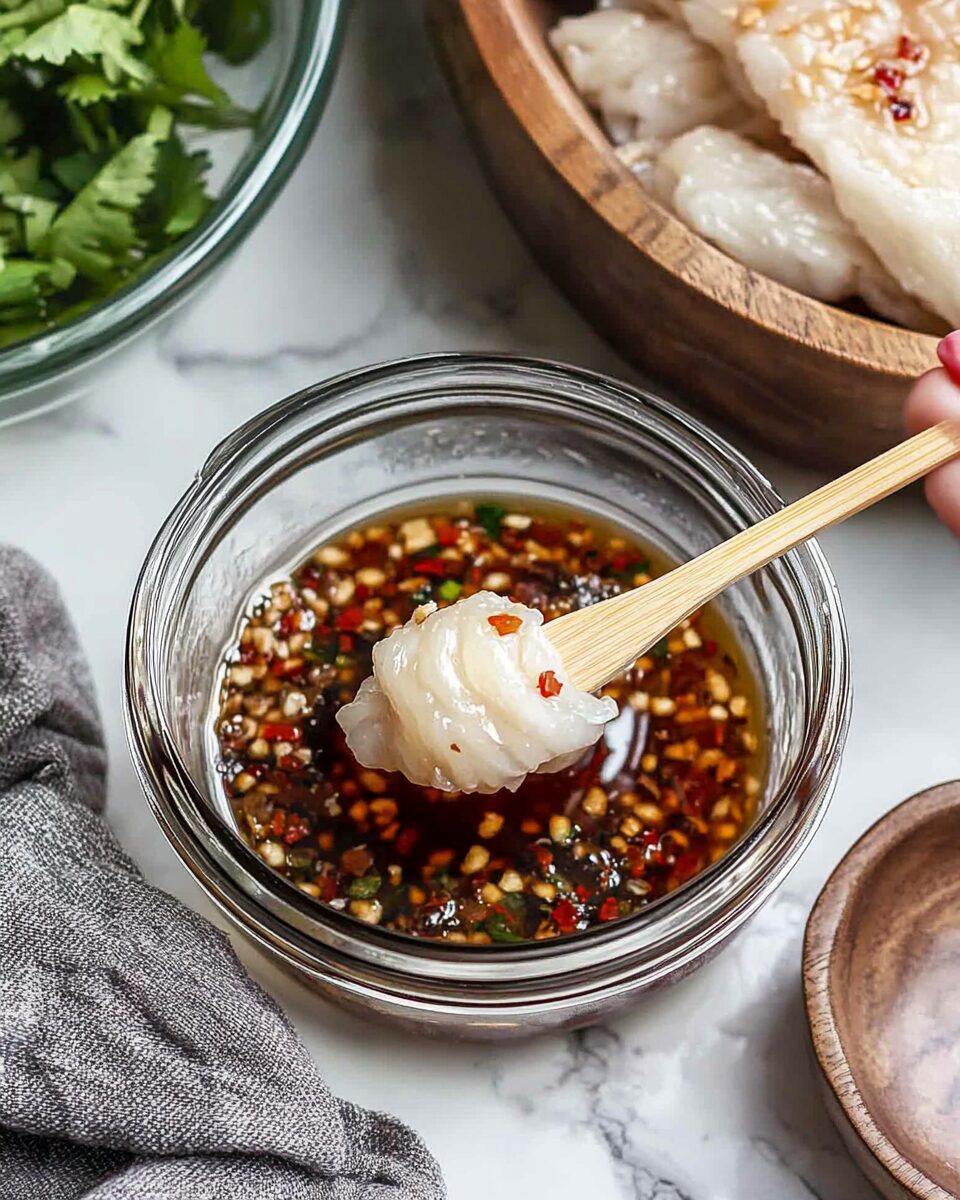A classic Filipino dipping sauce that perfectly complements grilled, fried, or roasted dishes. This simple yet flavorful combination of soy sauce and vinegar is often served with meat, seafood, and even vegetables. The tanginess of the vinegar blends harmoniously with the saltiness of the soy sauce, creating a bold and savory dip. Customize it with optional ingredients for a unique twist.
FULL RECIPE
Ingredients
- Soy sauce
- Vinegar (preferably white or cane vinegar)
- Red chili peppers
- Garlic
- Onion
- Sugar (optional)
- Black pepper
- Calamansi or lemon juice
Directions
- Combine soy sauce and vinegar in a small bowl. Adjust the ratio to suit your taste preference.
- Mince the garlic and finely chop the onion.
- Slice red chili peppers thinly for added heat.
- Mix them into the sauce for extra flavor.
- Add a pinch of sugar to balance the acidity, if desired.
- Squeeze fresh calamansi or lemon juice for a citrusy kick.
- Stir well and let it sit for a few minutes to allow the flavors to meld.
Nutrition Facts
- Calories: 20 per tablespoon
- Fat: 0g
- Sodium: 800mg
- Carbohydrates: 2g
- Sugar: 1g
- Protein: 1g
The Role of Soy Sauce and Vinegar in Filipino Cuisine
Soy sauce and vinegar are integral components of Filipino cooking. They are frequently used in marinades, stir-fries, and braised dishes. The balanced combination of salty soy sauce and sharp vinegar forms the base of many Filipino recipes like adobo and paksiw. Their versatility allows them to stand alone as a dipping sauce, embodying the essence of Filipino flavors in every bite.
Popular Variations of Soy Vinegar Dipping Sauce
While the classic version consists of just soy sauce and vinegar, regional and personal variations are common. Some prefer adding crushed ginger for a fresh, slightly spicy twist. Others include brown sugar to create a sweeter dip. For an extra umami boost, fish sauce can be mixed in. Certain regions also add finely chopped tomatoes or onions to the sauce, enhancing both its texture and flavor profile.
Presentation Tips for a Beautiful Serving
Serving this dipping sauce can be an opportunity to impress guests. Consider using a small, decorative dipping bowl that complements your table setting. Garnish the sauce with thin slices of red chili or a sprig of fresh cilantro for visual appeal. Providing individual dipping bowls for each guest ensures they can customize their sauce as desired.
The Environmental Impact of Homemade Sauces
Making your own dipping sauce is not only cost-effective but also environmentally friendly. By preparing it at home, you eliminate the need for store-bought sauces that often come in single-use plastic containers. Using fresh, locally sourced ingredients further reduces your carbon footprint, making it a sustainable choice.
The Versatility of Soy Vinegar Dipping Sauce
Soy vinegar dipping sauce is a staple in many Filipino households and a popular choice for various dishes. Its simple yet powerful combination of ingredients makes it an excellent complement to everything from grilled meats to fried appetizers. The balance of salty, tangy, and spicy flavors brings a dynamic contrast that enhances the overall dining experience. This sauce is often served with popular Filipino foods like lechon kawali, fried fish, or crispy pata, adding a punch of flavor with every bite. Additionally, it can be used as a marinade for meats or drizzled over steamed vegetables for an extra layer of zest.
Cultural Significance and Tradition
In Filipino culture, dipping sauces are not just condiments; they are an essential part of the dining table. Soy vinegar dipping sauce, often called “sawsawan,” is a prime example of this culinary tradition. The act of preparing and customizing the sauce to individual taste preferences is deeply embedded in Filipino food culture. Some people prefer a stronger vinegar presence, while others add more soy sauce for saltiness. The addition of calamansi juice, garlic, and chili peppers further personalizes the sauce, making it a reflection of the diner’s taste. It’s also common to see multiple versions of the sauce at family gatherings, allowing guests to tailor it to their liking.
Customizing the Flavor
One of the best features of soy vinegar dipping sauce is its adaptability. Those who enjoy a touch of sweetness can add a pinch of sugar, while others seeking more heat may opt for extra chili peppers. Minced garlic adds an aromatic depth, and freshly ground black pepper provides a subtle spice. Calamansi juice introduces a citrusy brightness that cuts through the richness of fried dishes. For a smokier flavor, some people even add a dash of liquid smoke or toasted garlic. Experimenting with these elements allows for endless variations, making the sauce truly versatile.
Health Benefits and Nutritional Value
This dipping sauce is a low-calorie addition to meals, with only around 20 calories per tablespoon. It is naturally fat-free, making it an excellent choice for those watching their fat intake. The sodium content can be high due to the soy sauce, but this can be reduced by using low-sodium soy sauce or adjusting the ratio of vinegar. Vinegar itself has been associated with various health benefits, including improved digestion and blood sugar regulation. Additionally, garlic and chili peppers are known for their antioxidant and anti-inflammatory properties. Incorporating soy vinegar sauce into meals can enhance flavors while offering potential health advantages.
Ideal Pairings for Soy Vinegar Dipping Sauce
Soy vinegar dipping sauce is most commonly paired with fried or grilled meats. Dishes like crispy pork belly, fried fish, and barbecue skewers benefit from the sauce’s tangy and salty contrast. It also complements lumpia (Filipino spring rolls), turning a crunchy bite into a flavor explosion. For a lighter pairing, drizzle the sauce over steamed vegetables or use it as a dressing for simple cucumber or tomato salads. Some people even enjoy it as a dipping sauce for steamed dumplings or gyoza, proving its versatility beyond Filipino cuisine.
Making It Ahead and Storage Tips
This sauce is incredibly easy to prepare and stores well, making it ideal for meal prepping. Simply mix the ingredients in a clean jar and refrigerate. Over time, the flavors will deepen as the garlic and chilies infuse the vinegar and soy sauce. For best results, consume the sauce within a week, although it may last longer if stored properly. If any solids like garlic or chilies are removed, the liquid base can last even longer. Always shake or stir the sauce before using to ensure the flavors are well distributed.
Conclusion
Soy vinegar dipping sauce is a timeless and essential part of Filipino cuisine. Its vibrant blend of salty, tangy, and spicy notes makes it an irresistible companion to a variety of dishes. Whether served with fried delicacies, grilled meats, or fresh vegetables, this sauce adds an extra layer of flavor that enhances the overall meal. With endless customization options and potential health benefits, it’s a must-have in any kitchen. Give it a try and discover why this simple yet powerful sauce has become a beloved staple at Filipino tables worldwide.






